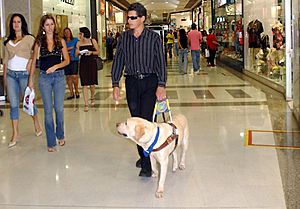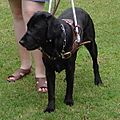Guide dog facts for kids
Guide dogs are special dogs. They are trained to help people who cannot see well (blind people). These dogs help them live more independently. Sometimes, they are called "Seeing Eye" dogs. Guide dogs are a type of assistance animal. Assistance animals are trained to help people with a disability. They help people live fuller lives.
A blind person who works with a guide dog is called a "handler." The handler and the dog must learn to work as a team. They both go through special training. The handler tells the dog where they want to go. The dog then guides the person safely. Guide dogs can lead people around dangerous things. This includes moving cars or other obstacles. Some guide dogs can even press buttons for elevators. They can also fetch items for their handler. Dogs do not see colors as well as people. So, they cannot read traffic signals. The handler must use other ways to know if it is safe to cross a street.
Guide dogs and their handlers often go to public places. It is important that the dog stays calm. This is true even in busy or noisy areas. In many countries, guide dogs can go into places where other animals are not allowed. This includes restaurants, stores, buses, and trains.
Contents
History of Guide Dogs
Early Guide Dog Schools
The first guide dog schools started in Germany. This happened during World War 1. These schools helped soldiers who lost their sight in the war.
Growing Support for Guide Dogs
By 1931, more schools and groups were created. One famous school is The Seeing Eye. It is located in Morristown, New Jersey in the United States. The British Guide Dog Association also started in the United Kingdom. These groups helped more blind people get guide dogs.
Related pages
Images for kids
-
A blind man with his guide dog in Montreal, 1941
-
Labrador Retriever guide dogs resting
-
Social psychologist Elliot Aronson and his guide dog, Desilu, whom he received in January 2011
See also
 In Spanish: Perro guía para niños
In Spanish: Perro guía para niños









